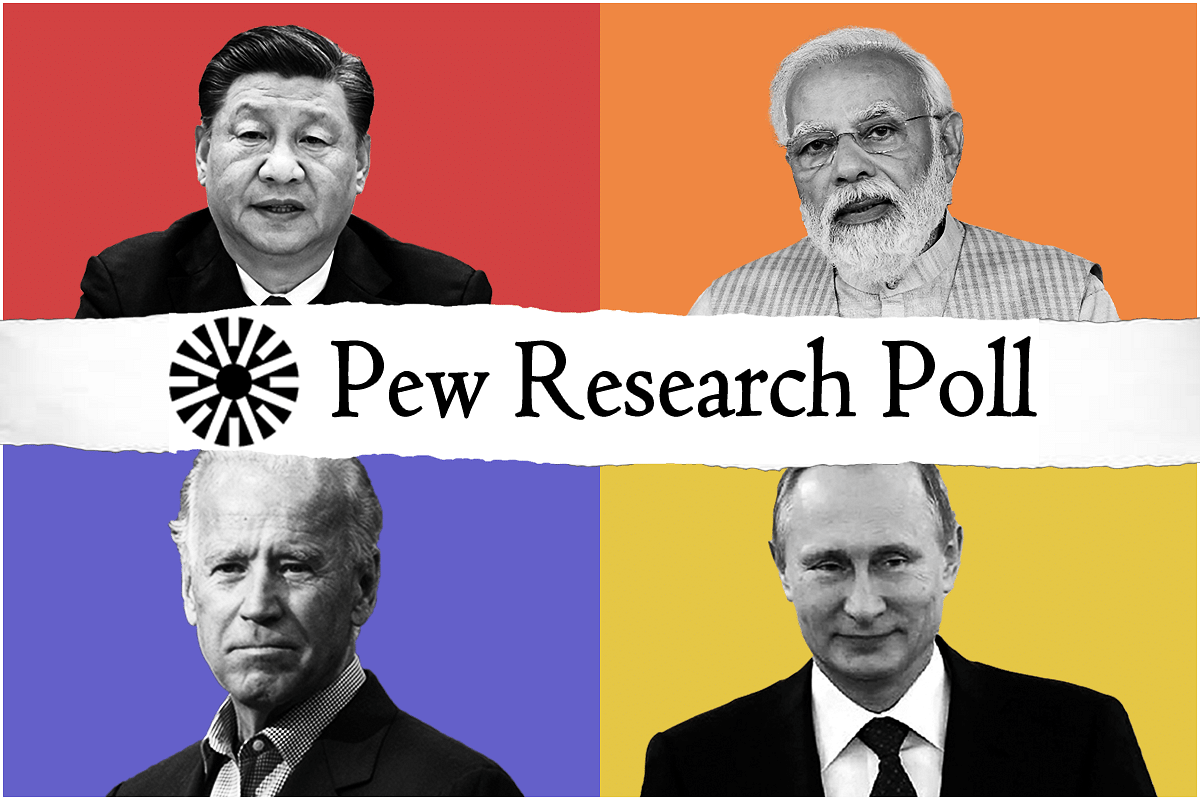Context
Rising Influence: India Gets 28 Per Cent Approval Rate Globally In Pew Research Poll

Chinese President Xi Jinping, Prime Minister Narendra Modi, US President Joe Biden and Russian President Vladimir Putin
A median of 28 per cent of respondents across 19 countries — including America, Canada, 11 European nations, five from Asia, and Australia — felt that India’s influence on the global economy was rising.
How the countries fared: India came in at fourth place on the poll.
China ranked at the top with 66 per cent of the respondents acknowledging her rising stature. China has been consolidating its position as an emerging superpower over the last two decades. The rise was particularly evident after President Xi Jinping launched the ambitious Belt and Road Initiative (BRI).
Russia came second with 41 per cent.
The US was ranked third, with 32 per cent of the respondents rooting for her. From shoddy handling of the Covid-19 pandemic by the Trump administration, the rise of the China-Russia axis, and the apparent helplessness of the Joe Biden administration in reining in Moscow — there was not enough to say in America’s favour.
India's perception before: Until recently, India was considered a ‘benign power’ with limited resources and ability to match the aggressive Chinese competition.
When China launched the BRI in 2013, India was sitting on empty promises to the neighbourhood.
From the International North-South Transport Corridor (INSTC) to Chabahar Port, Trilateral Highway, or Kaladan Multimodal, India disappointed.
Even the India-Bangladesh development partnership programme was stalled, as the first line of credit of $1 billion (2010) was barely disbursed and the age-old conflicts on land and maritime boundaries continued. Coastal shipping and defence cooperation didn't materialise too.
The Indo-Sri Lankan defence cooperation treaty was called off by the UPA government in 2004 due to coalition compulsions.
From the Maldives to Nepal, China had a framework ready to take the neighbourhood by storm, and so they rolled out BRI while India looked on.
Change under Modi: A series of policy programmes over a period of time has led to an upswing in India's perception globally.
Several projects, including the INSTC and the Chabahar Port, have started operations.
Sittwe Port is complete and construction of the Sittwe-Mizoram road link and the Trilateral Highway is continuing despite the turbulence in Myanmar.
Neighbourhood focus: Several outreach initiatives have led to India being perceived as a reliable partner.
The Maldives was rescued from the Chinese debt trap.
Indo-Sri Lankan cooperation is on fast track.
The Nepalese government now is resisting BRI loans.
Resolving the status of J&K was arguably the biggest development that took place on the geostrategic front. It denied the China-Pakistan axis its traditional clutch on India’s domestic policies.
The Pakistan conundrum: The biggest change that has come is in India's mindset.
The Balakot air strike robbed Pakistan of its ‘nuclear power’ safety badge to send non-state actors to cause bloodbaths in India.
Modi dared to dump SAARC and take regional cooperation ahead, minus Pakistan.
India’s economic integration with neighbours increased manifold over the last decade, thanks to the single step of isolating the rotten apple.
Today, Pakistan is eager to resume trade with India for its benefit.
Military reforms: Stepping on the gas in defence sector modernisation with faster implementation of pending military logistics projects made India's hard power more potent.
A major improvement in infrastructure and connectivity across the country, particularly in the border areas in the north, has increased India’s readiness to take on a challenge both militarily and economically.
Improving on UPA schemes: Energy transition, dedicated freight corridor, encouraging startup development — these were projects of the previous governments. Modi gave them scale.
From railway to rural electrification, projects were implemented at an unprecedented pace.
GST was proposed in 2000. For the next 14 years, there was no progress. Modi implemented it in 2017.
The UPA government had set up the UIDAI to produce cheap biometric I-cards that would be key to the direct transfer of social benefits, but Modi made it a powerful tool of citizen-centric programmes.
Similarly, universal access to toilets, drinking water, and banking services were schemes with no end in sight until Modi called for their completion.
The spree to open zero-balance bank accounts (Jan Dhan) later became the backbone of India’s path-breaking mobile interface payment system.
Battling Covid-19: Given the status of health infrastructure as of March 2020, not many were ready to count on India’s ability to fight the pandemic.
But leveraging technology meant Covid-19 vaccination was available for all.
India's economic recovery post-Covid-19 was also remarkable with the government working overtime to ensure nobody went hungry while simultaneously reforming the economy.
The shift under PM Modi has been one of a dormant civilisation waking up to its true potential and taking definitive steps to get there. Modi at the helm of affairs signifies a stable government that is strong, transparent, and citizen-centric.
Introducing ElectionsHQ + 50 Ground Reports Project
The 2024 elections might seem easy to guess, but there are some important questions that shouldn't be missed.
Do freebies still sway voters? Do people prioritise infrastructure when voting? How will Punjab vote?
The answers to these questions provide great insights into where we, as a country, are headed in the years to come.
Swarajya is starting a project with an aim to do 50 solid ground stories and a smart commentary service on WhatsApp, a one-of-a-kind. We'd love your support during this election season.
Click below to contribute.
Latest